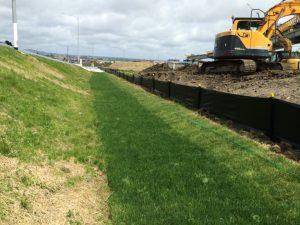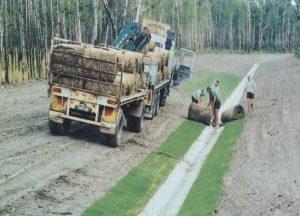Erosion Control
Soil and surface stabilisation practicesTurfing
What, why, when and issues to look out for
What
Turfing means to lay a continuous cover of grass turf to permanently stabilise a disturbed area.
Why
Laying turf gives instant results, both from an erosion control perspective and visually. It stabilises exposed areas by simply putting vegetative cover on top of them.
When
This practice is typically only used for:
- Critical erosion-prone areas on the site that cannot be stabilised by conventional sowing or other stabilisation methods
- Runoff diversion channels and other areas of concentrated flow where velocities will not exceed the specifications for a grass lining
- Providing a vegetative filter or buffer along footpaths, driveways, kerbs, swales and channels
- Areas around grass stormwater inlets, swales, embankments, road berms and other areas that require immediate grass cover for landscaping purposes.
Issues to look out for
- Turfing can be a relatively expensive option to achieve a stabilised surface. However, it has the dual advantage of providing both erosion control and landscaping.
- Turfed areas will need good watering during dry periods, otherwise the grass will die and erosion control will not be achieved.
Design essentials

Turf used to provide quick stabilisation of the swale allowing for the early commissioning of a swale (Source: SouthernSkies).
There are no specific design criteria for turfing, but you should follow these principles.
Choose turf that is suitable to the ground conditions and to its final use.
Take care that flow speeds travelling over the turfed area will not cause erosion or undercut the turf. If undercutting is a risk – which is more likely to happen in steeper areas – consider reinforcing the turf with geotextiles. Check the manufacturer’s specifications for flow velocities applicable for the various geotextiles.
Construction, operation and maintenance
When constructing and operating turfing
- You need to prepare a good base for the turf to succeed. The base should be loose, uniform and free of large clods and other objectionable material.
- If turfing onto a subsoil with poor potential for grass survival, cover it with compost or mulch before turfing.
- If the weather is hot, irrigate the base just before you lay the turf.
- Lay turf on the contour, never up and down the slope. Start at the bottom and work up slope.
- Butt joints tightly (push them up against each other tightly), and do not stretch or overlap.
- For slopes steeper than 3:1, secure the turf to the ground with pegs or other means. Roll and tamp (pack down) the turf immediately to make sure that it has solid contact with the ground.
When maintaining turfing
- In the first week after laying, water it daily (unless there is enough rain). Keep watering as needed to maintain good growth until it is fully established.
- Check that the turf is firmly rooted to the original ground surface before you mow it.
- Apply fertiliser as required according to the supplier’s specifications.
